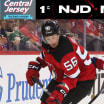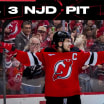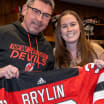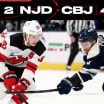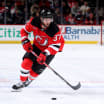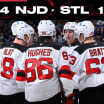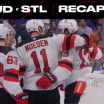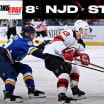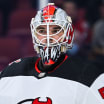Some hockey games are easy to define and others can drive you nuts trying to figure the whys and wherefores of what happened before your very eyes.
Explaining Game 6 of the interstate conflict between the New Jersey Devils and New York Rangers would defy the keenest brains of the analytics fraternity among other graduates of higher hockey learning.
"Based on what happened," said a reporter from the Bergen Record, "you could spend a lifetime trying to figure out why things went the way they did. The see-saw did a heckuva lot of see-ing and saw-ing."
For the Devils Faithful, things started out well and got better by the minute,
Writing in his definitive book - "Battle On The Hudson" - about the series, author Tim Sullivan had no qualms about putting the contest in historic perspective.
"It would be the most important game of the season," wrote Sullivan, "and perhaps history for both franchises."
The Devils Happy Half of Game 6 | SUNDAYS WITH STAN
Things were looking up for New Jersey, which had a 2-0 lead against the Rangers in the first half of Game 6
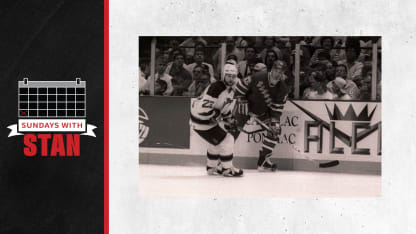
sundays with stan
DEVILS-RANGERS, 1994 EASTERN FINAL
Part 6: Prelude to Game 6 Melodrama
Part 5: The Devils' Offensive
Part 4: Ultra Suspenseful Game 3
Part 3: Can the Devils Do It Again!?
Part 2: Devils Upset Rangers in Game 1
Part 1: Prelude to the Historic Series
The Devils, who needed only one win to clinch the tourney, would seem to have had a psychological advantage. They were at home in the Meadowlands Arena and were the underdogs. They played with house money.
They also boasted an exceptionally gifted rookie goaltender in Martin Brodeur. Within weeks, he would be named winner of the Calder Memorial Trophy as National Hockey League rookie-of-the-year.
"The way Marty came on during the season," said assistant coach Larry Robinson, "I saw a resemblance to (Hall of Famer) Ken Dryden when I played for the Canadiens."
Brodeur had not been expected to grow in competency so fast. At training camp in September 1993, veteran Chris Terreri had been the designated starting goalie but Marty had emerged as the ne plus ultratop banana in no time at all.
And now he found himself on the brink of yet another major accomplishment. Everyone in the Devils camp, from the stickboy to owner Dr. John McMullen, could feel the winning beat.
"That first period went the way we'd hoped it would," Doc Mac later would remind friends when Game 6 became the topic of conversation. "The boys were skating well and the Rangers looked like the losers."
Time and again, Red Jerseys would blow into the enemy zone with hurricane force, leaving the Visitors sometimes in orderly and other times disorderly retreat.
"The Rangers were scrambling from the opening drop," wrote Sullivan, "and the Devils sensed it."
So did Mike Richter in the New Yorkers' goal. There are some goaltending-watchers who later would claim that the first eight minutes of Game 6 was the best in Michael's career.
"At that point," said Rangers radio play-by-play man Howie Rose, "Richter was stealing the game."
But the Law of Averages finally broke the Devils way.
Their offensive was organized by an unusual defense pairing of slow-paced Slava Fetisov and fleet Scott Niedermayer. Valeri Zelepukin joined the duet and Richter knew there was trouble.
"It was Zelepukin who I was eyeing once the Devils entered our zone," said Richter.
Zelly needed watching. The likeable Russian had come on strong during 1993-94. Big with long, solid strides, Valeri had gained room in the right corner of the Rangers zone.
"I saw Nieder pinching from the blue line," Zelepukin remembered, "and there was no better play than to pass him the puck."
The way Richter was playing, Scott's shot might have been saved. But the rubber ricocheted off Ranger forward Sergei Nemchinov's stick before orbiting over the goalie's shoulder.
New Jersey 1, Rangers 0.
From that point forward, the Devils played Lemaire hockey. And when they deviated - as in a minor penalty to Bobby Holik - their PK men played A-1 defense and they rode out the storm.
"We were gaining confidence," said Holik. "We kept pushing the offensive."
Holik was part of it. Later in the opening frame he fed a nifty pass to Bernie Nicholls, who then spotted Niedermayer. Now the Devils had crowded the Rangers zone with pesky Claude Lemieux trying to screen Richter.
Nicholls: "I saw Scotty (Niedermayer) pinching and sent him my pass. Nieder fired a one-timer at Richter, hoping some good would come of it."
Sure did; Lemieux was right in front and deflected it past Richter.
New Jersey 2, Rangers 0.
If Rangers coach Mike Keenan was known for anything, it was impatience with his goaltenders. Richter knew all about it and was smart enough after the second goal not to even take a peek at his glorious leader.
But Keenan knew what every last fan among the 19,000-plus jamming the arena knew; Richter was the rope that kept the Rangers package together. No way, Mike would get the hook.
The first period ended just the way New Jersey wanted. Lemaire's game plan was working. Nothing was broken; hence nothing had to be fixed.
That was not the case on the other end of the arena corridor. As I made my way to our television studio, I heard a commotion at the other end.
They were not happy sounds; more like anger and Mark Messier could be seen in the midst of the crowd. That was all I could see and hear. There was no time to hang around; I had to get to work.
So did the Devils as the second period got underway. The 2-0 lead only was as good as the next goal and forwards such as John MacLean knew it only too well.
"There was a lot of firepower on the ice and on their bench," said the Devils sharpshooter. "We wanted another one, just to be sure."
As it happened, Johnny Mac was the Devil who had the chance-of-all chances to put the ribbon on that gift which could have led to the Devils series victory.
Working along with Stephane Richer on his line, Johnny was in full flight. He was The Man who lifted New Jersey into its first playoff in 1988 and continued to be Mister Clutch.
Meanwhile, Richer, the smooth French-Canadian, lured two Blueshirts to cover him behind the net. In no position to score, Steph backhanded a pass to MacLean.
It was the moment of truth. Johnny Mac accepted the pass a dozen feet away from the goal. He tamed the rubber and then fired toward the yawning twine; but the rubber never reached the cords.
As the capacity crowd anticipated a flashing red light, Richter somehow managed to move in such a way that the puck whacked him under the arm but never squeezed through.
The rubber fell in front of the goaltender not behind him; nestling atop his goalie skate. While the Devils' Faithful groaned in disbelief, the Rangers netminder smothered the disk, forcing a face-off.
Behind the Visitors' bench, Keenan racked his brain for a counter-ploy. The best he could do was wave over the game officials and call a time-out.
"It was," commented author Tim Sullivan, "one of the league's most notable time-outs."
That forever will be a matter of debate because the Blueshirts coach said nothing and once play resumed nothing consequential was accomplished by the Seventh Avenue Skaters.
The expression "golden opportunity" has been so beaten to death by broadcasters that it long ago lost its true meaning. But for one split second the Devils created one more chance to salt away the series.
Tom Chorske, who had matured into one of New Jersey's most threatening shooters, actually beat Richter with his drive, but it hit the post and rebounded the wrong way for New Jersey.
Next, defenseman Tommy Albelin teed off with a slapshot while Chorske tried screening Richter. This, too, could have been the winner but it missed the mark.
Time began running out in the second period but not fast enough for Jacques Lemaire. With less than two minutes remaining, the score remained New Jersey 2, New York 0.
Then it happened!

